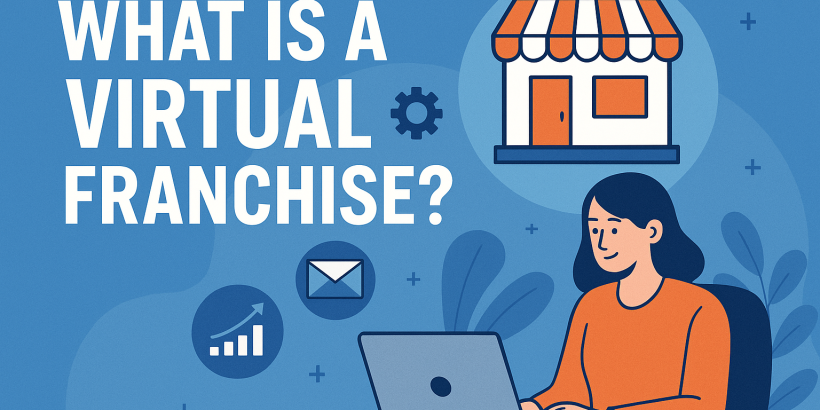We’re all familiar with traditional franchises, think fast food chains like McDonald’s, cleaning services like Molly Maid, or retail stores like UPS. These are businesses you can buy into and operate under a proven brand name, usually with support, systems, and a solid track record behind you.
But what if you want the same kind of support and brand power without a storefront or physical location?
That’s where virtual franchises come in.
What is a virtual franchise?
A virtual franchise, often referred to as a home-based or online franchise, is a business model that allows you to operate a franchise remotely through online channels.
It offers the benefits of a traditional franchise (like branding, marketing, systems, support, and a proven business model), but allows you to work remotely and often set your own schedule. Think of it like buying into a digital business that’s already set up to work online.
- Examples of virtual franchises include:
- Digital marketing services
- Online tutoring platforms
- Virtual assistants or remote admin agencies
- Remote travel planning businesses
- E-commerce franchises with drop shipping or fulfillment built in
A Virtual Franchise is Not MLM!
If you’re researching virtual work opportunities, you’ve likely stumbled across MLMs (multi-level marketing) companies, too. They often claim you can “own your own business,” but they’re not the same thing as a franchise — virtual or otherwise.
MLM businesses rely heavily on recruiting other people and building a “downline” in order to make real money. While there are exceptions, most MLM models are designed to benefit those at the top and can be financially risky for new participants.
You may have even experienced the typical MLM pitch: a vague call from a long-lost acquaintance offering a “wellness opportunity” or encouraging you to watch a mysterious video (see this Reddit post for a real-life example). These companies, like Amway, Vector, or Juice Plus, are structured very differently from franchises.
A virtual franchise is different. You’re offering a real product or service, not recruiting others to join. You’re backed by a real brand, with real support, and you make money by running the business — not by bringing in more people.
How to Get Started with a Virtual Franchise
1. Know What Interests You
Start by identifying your interests, strengths, and goals:
- Do you want to work part-time, full-time, or on a flexible schedule?
- Do you care most about teaching, tech, travel, health, pets, or e-commerce?
- Do you prefer service-based or product-based businesses?
This will help narrow your options.
2. Explore Reputable Franchise Portals
The easiest way to browse legitimate opportunities is through trusted franchise directories. These platforms allow you to filter by business type, industry, investment level, and location (with many focused on home-based or online models).
Here are some great places to start:
Franchise Direct – Home-Based Franchises
Franchise Direct is one of the most established franchise portals, with listings for hundreds of home-based and virtual opportunities. You can filter by industry or investment level and access detailed info about each franchise.
Franchising.com – Home Based Franchise Opportunities
Offers news, resources, and a directory of franchise opportunities. The site is geared toward both franchisees and franchisors, providing industry insights.
Franchise Gator
This site lets you compare franchises by budget and lifestyle preferences. It also offers tools like an investment calculator and franchise quiz to help you match with the right opportunity. For virtual, choose “Home Based Business” from the first drop down (all industries).
Entrepreneur’s Franchise 500
A well-known industry benchmark. Be sure to filter the list to include home-based and mobile options to explore virtual franchises.
FranchiseOpportunities.com – Home-Based Franchises
A well-established directory that connects prospective franchisees with franchisors across various industries.
Note: A franchise that’s listed across multiple directories and has clear, transparent information (like costs, support, and expectations) is usually worth deeper research. Avoid anything vague or overly “hype” driven.
3. Understand the Costs
Startup costs for virtual franchises vary widely:
- Some opportunities start under $5,000
- Others can range from $10,000–$50,000 depending on the brand and support
Be sure to consider:
- One-time franchise fees
- Monthly or annual royalty fees
- Marketing or software costs
- Any equipment or tech setup
4. Evaluate Support and Structure
A good virtual franchise should offer:
- Onboarding or training
- Branding and marketing assets
- Access to systems (CRM, email platforms, e-commerce backend, etc.)
- Ongoing support or mentorship
Look for transparency about what you’ll actually get as a franchisee.
5. Ask Questions and Read the FDD
Every franchisor is legally required to provide a Franchise Disclosure Document (FDD). It outlines the business model, obligations, costs, restrictions, and legal terms. Don’t skip it! And don’t be afraid to ask questions or consult a franchise attorney.
6. Watch for Red Flags
Trust your instincts. If it sounds too good to be true, it probably is. Be cautious of:
- Overpromising results (“Make $10K your first month!”)
- Heavy focus on recruiting over actual service or sales
- Hidden fees or evasive answers
- Poor online reviews or no mention on trusted directories
Any opportunity that emphasizes recruiting over selling a product or service might veer into MLM territory.
NOTE: If a franchise isn’t listed on any of these major portals, do some extra homework. While not a deal-breaker, being absent from trusted directories can sometimes be a red flag.

